|
The following is a step-by-step procedure for analysis a two-dimensional truss
structure using SAP2000. The order of some of these steps is not critical; however,
all step should be completed before execution of the the analysis. If you have any
questions, or you you find any of these instructions unclear or inaccurate, please contact
Dr. Charles Camp.
To help students become familiar with some of the numerous aspects and features of SAP2000, the following tutorial will focus on determining the forces in each member of the
roof truss shown below. Assume all
members are pin connected.
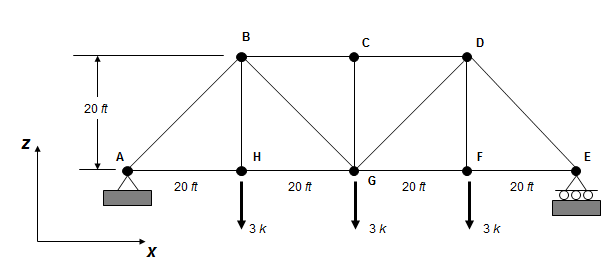
When you start SAP2000 Educational Version 7.4 you should see the
following interface window:

| Step
1: Set Problem Dimensions - On the bottom on the interface window, set the
desired units for the problem using the pull-down menu. In this example, the units are feet
and kips. |
 |
Step 2: Grid Spacing - Determine the appropriate number of
grid line and grid spacing to locate the joints of the truss. The grid spacing is set by
defining a new problem. To create a new problem, select New Model
under the File menu.
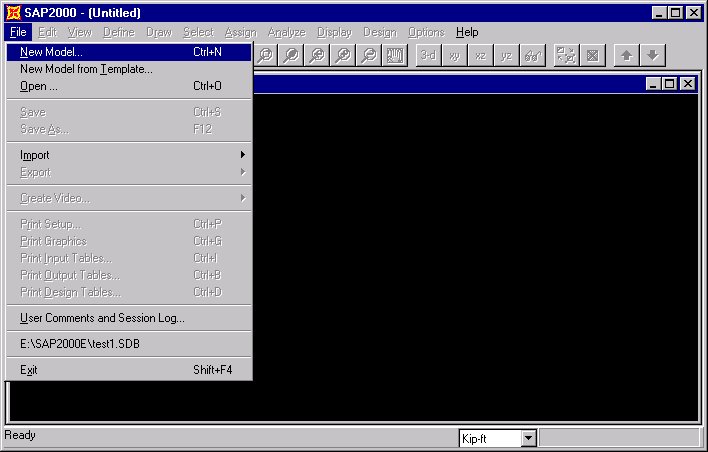
| When
you select New Model on the menu, the Coordinate System Definition
window will appear (see the figure on the right).
Remember,
that SAP2000 assumes that your two-dimensional structure resides in the x-z plane.
Define
your grid system by entering data on the Coordinate System Definition
window. For the truss shown above, the the grid spacing in the x and z-directions is 20
feet. The number of grid spaces in the x and z-directions are 4 and 1, respectively. No
y-direction grid line are necessary for this problem.
When you click OK, SAP2000 generates the grids line you have just
defined and shows you the grid system in the SAP2000 interface window.
By default SAP2000 show two views of your problem, typically a 3-D view and an x-y
plane view. To adjust the views, select an window and click on the appropriate view button
located along the top edge of the interface window. |
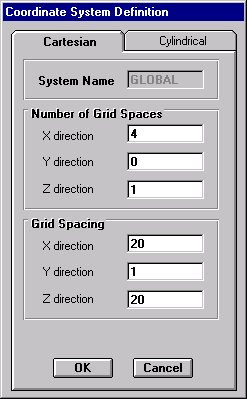 |
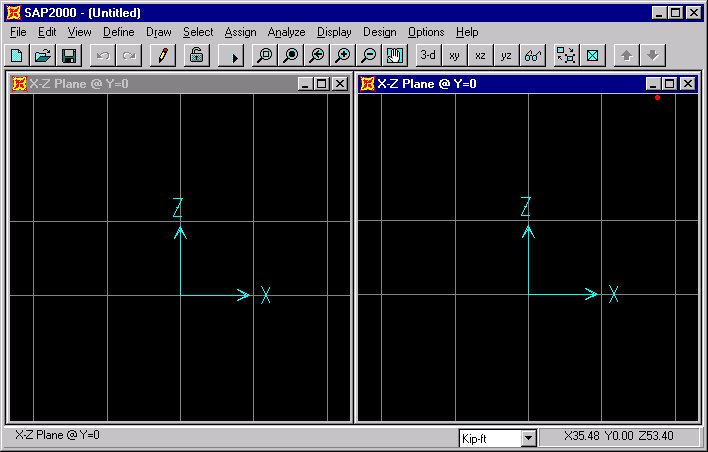

Step 3: Locate Truss Joints - To define the joint
locations, select the Draw Special Joint button  on the
lower tool bar. Click on grid intersection lines to define joints. For this problem the
joint locations are shown below: on the
lower tool bar. Click on grid intersection lines to define joints. For this problem the
joint locations are shown below:
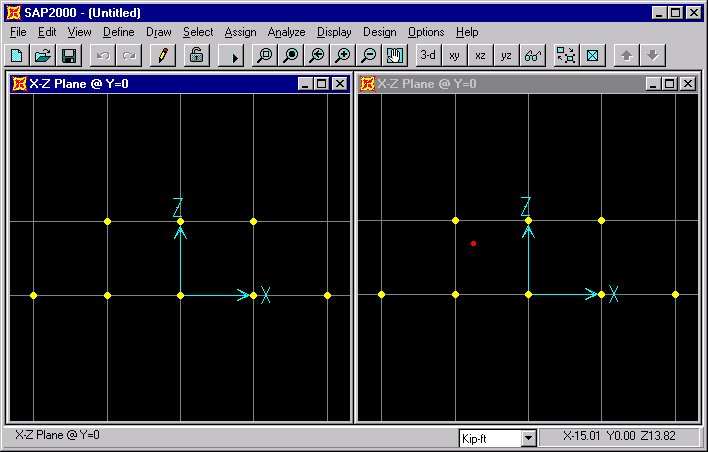

Step 4: Draw Frame Elements - To define each
frame element, select the Draw Frame Element button
 on
the lower tool bar. To define an element, click on a joint at the beginning of the element
and than on the joint at the end of the element. To end a series of element definitions,
simply double-click on the final joint. For this truss problem, the frame elements are
shown below: on
the lower tool bar. To define an element, click on a joint at the beginning of the element
and than on the joint at the end of the element. To end a series of element definitions,
simply double-click on the final joint. For this truss problem, the frame elements are
shown below:
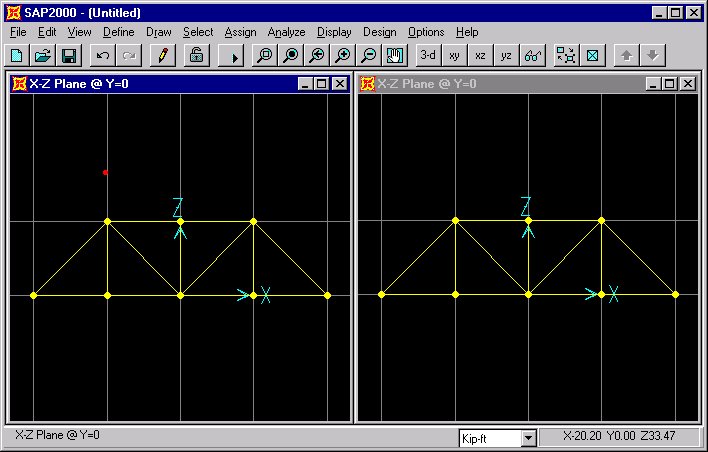

Step 5: Define Structural Supports - To define
the location and type of structural support, select the support location by clicking on
the joint with the pointer. A yellow "X" should appear at the joint to indicate
that it is currently selected. Next click on the Joint Restraint button
 on
the bottom tool bar. on
the bottom tool bar.
After the supports have been defined the truss problem should appear in the SAP2000
interface window as follows:
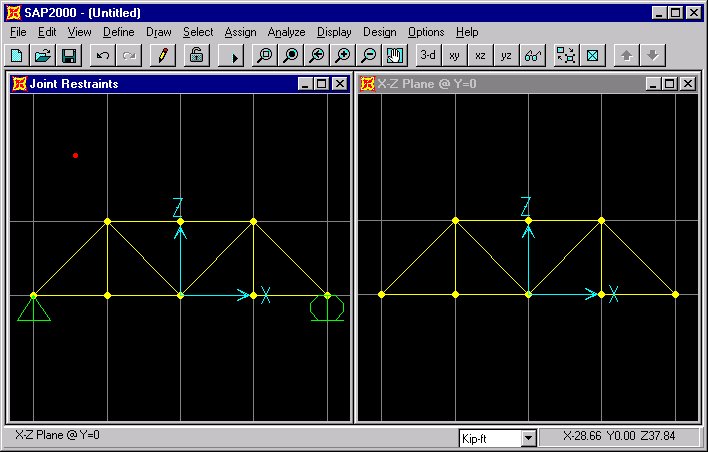

Step 6: Apply Forces at Joints - To apply forces at a
joint, select the joint with the pointer and click on the Assign Joint Loadings
button
 . The following menu will appear: . The following menu will appear:
| In this
example, there are three 3 kip forces acting along the bottom cord of the truss. Remember
that the truss was modeled in the in the x-z plane, therefore the forces are acting in the
negative z-direction. Enter -3.0 in the Forces Global Z input field and
click OK. The forces should be should be displayed on the truss (proper
direction and magnitude) in the SAP2000 interface window. |
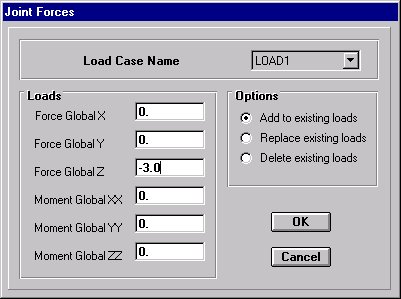 |
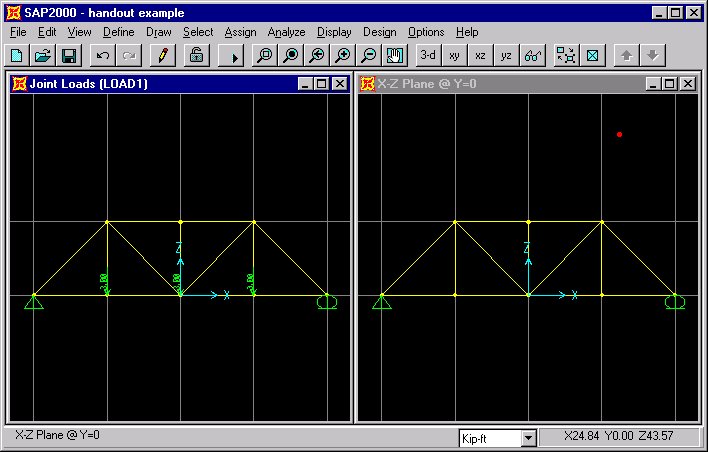

Step 7: Release Internal Moments at Joints - SAP2000
assumes that all structures are frames. Therefore, to analyze a truss structure we should
convert each joint from a fixed connection to a pin connection. To ensure that every joint
in the structure is pin connected, select all the members by clicking the Select
All button on the bottom tool bar. Next click on Assign menu and
select Frame then Releases and the and Frame
Releases window will appear.
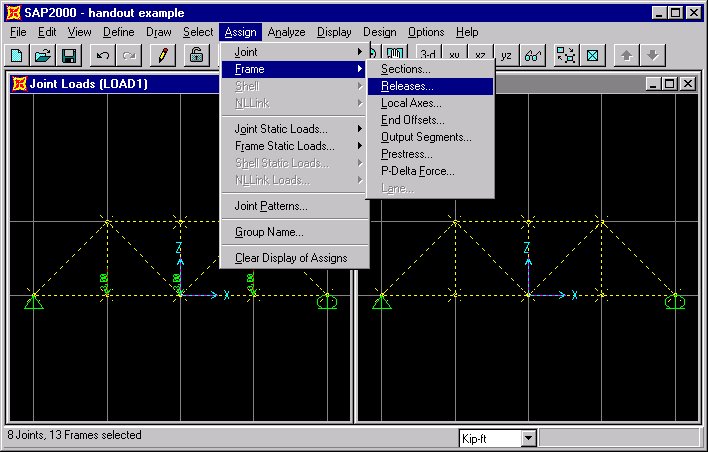

| In this
example, the structure is a truss, which by definition has no moment capacity at each joint.
To release the moment capacity, click on the check boxes that are associated with the Moment
22, Moment 33, and Torsion. Torsion can only be
released at one end of the element, whereas, the other moment must be released at both the
Start and End of the element.
After the moments are released, the truss structure should appear in the SAP2000
interface window as follows: |
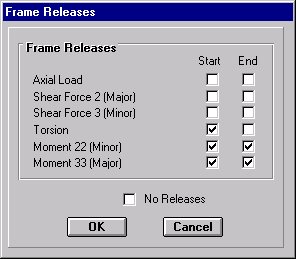 |
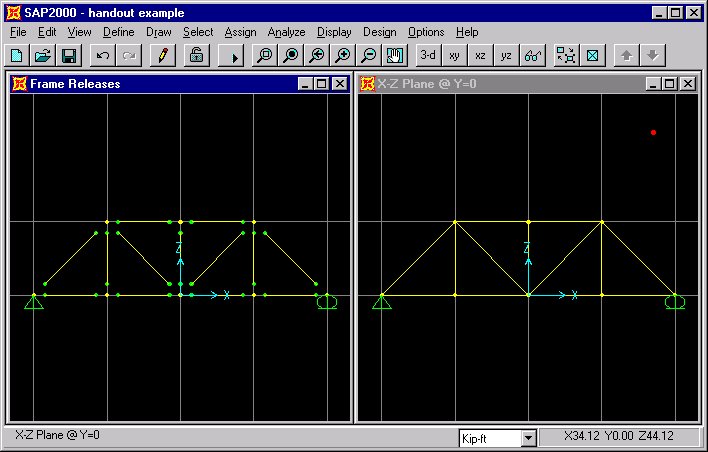

Step 8: Define Material Properties - SAP2000 assumes the
loads acting on a structure include the weight of each weight. In our truss analysis, we
assume that each element is weightless. To define the properties of a material , select
the Define menu located along the top the SAP2000 interface window and
then click on Materials. The Define Materials window will appear as shown
below:
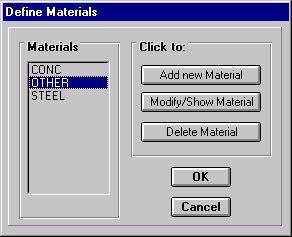 |
On this menu
you can change the properties of materials. In this example, select the OTHER
material and click on the Modify/Show Material button.
The Material Property Data window will appear.
|
Change the
value in the Weight per unit Volume input field to zero. Click OK to return to the Define Materials window and
than click OK again. Now we have a material named OTHER that has no weight per volume.
For this example problem, the default values for the Mass per unit Volume,
Modulus of elasticity, Poisson's ratio, and the Coeff of thermal expansion can
be used. For most linear elastic statically loaded structures only values for
Weight per unit Volume and Modulus of elasticity are required.
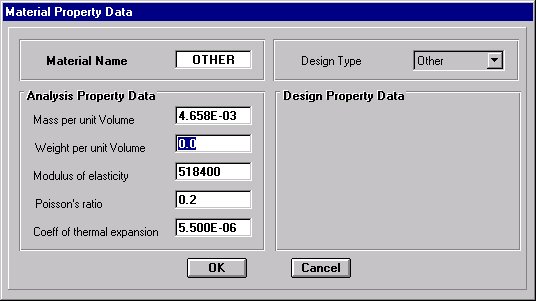
Step 9: Define Frame Sections - To define the cross-section
properties of a structural element click on the Define menu located along
the top the SAP2000 interface window and then click on Frame Sections.
The Define Frame Sections window will appear as shown below:
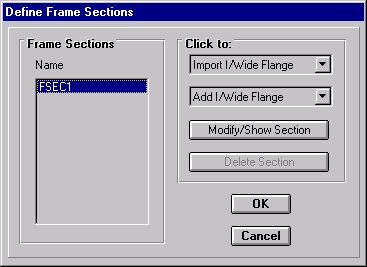
The default
Frame Section label is FSEC1. To change the properties of the frame
section click on the on the Modify/Show Material button.
The Rectangular Section window will appear.
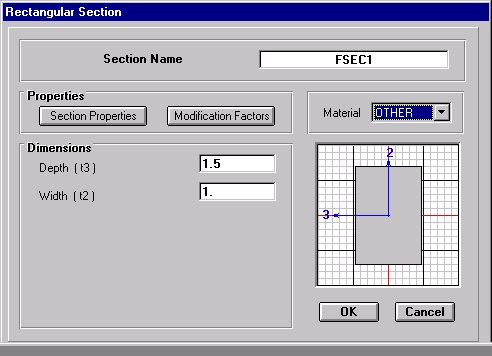
To the material
of this frame section click on the Material pull-down menu and select our
weightless material OTHER. Click OK to return to the Define Frame Sections
window and than click OK again. If you are interested in
computing deflections in the truss, then you must define the Depth (t3) and
Width (t2) of the cross-section. In this example, we are interested only in the
axial forces in a determinate truss, so the value of the cross-sectional areas
are not important.
Step 10: Assign Frame Sections - To assign the
cross-section properties of a structural element, select the element with the pointer and
click on the Assign menu located along the top the SAP2000 interface
window and then click on Frame Sections. You can assign the same section
properties multiple elements by selecting all the elements that share the same properties.
The Frame Section name will appear next to each element selected. After the frame sections
have been assigned the SAP2000 interface window will appear as follows:
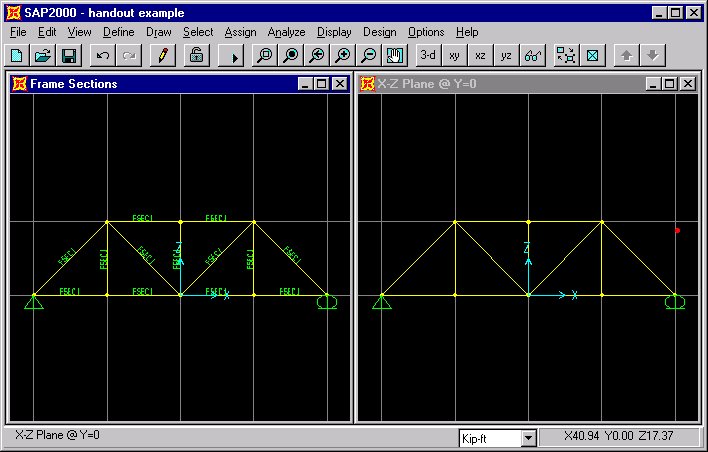

Step 11: Set Analysis Options
and Run Analysis - In
this example, the truss structure is modeled in the x-z plane. To limit analysis to
variables in the x-z plane click on the Analyze menu located along the
top the SAP2000 interface window and then click on Set Options. The Analysis
Options menu will appear as follows:
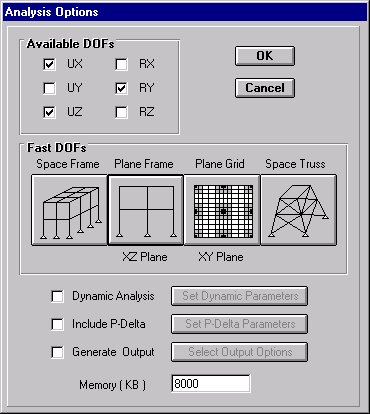
To restrict SAP2000 to variables in the x- plane, select the Plane Frame button and
click OK. The truss structure is now ready for analysis. To analyze the model press the Run
Analysis button
 . .
If the analysis is successful, the Analysis Complete window will
appear and report the the analysis is complete. Click OK and the
SAP2000 interface window will display an exaggerated deflected shape of the modeled
structure.
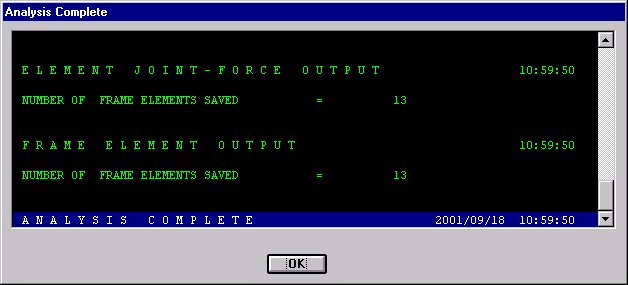
If the window reports that the analysis is incomplete, make sure that the moments have
been released and that the analysis options have been set correctly.
After
the Analysis Complete window has been closed, typically SAP2000 displays the deflected shape of the structure as shown below:


Step 12: Print Truss Forces - To get a quick feel for the
relative magnitude of the forces in the truss, select the Member Force Diagram for
Frames button
 along the bottom tool bar. The Member
Force Diagram for Frame menu will appear as follows: along the bottom tool bar. The Member
Force Diagram for Frame menu will appear as follows:
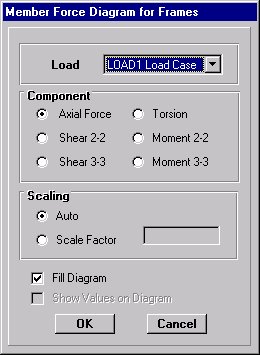 |
The default
values will display the Axial Forces using the Fill Diagram. If
you click OK, the SAP2000 interface window will display the relative magnitude of the
axial forces with compress forces in red and tension forces
in yellow.
Another way to display force information is to unclick Fill Diagram
and click on Show Values on Diagram. In this case, the value of each
axial force will be displayed next to the member (see the figure below). |
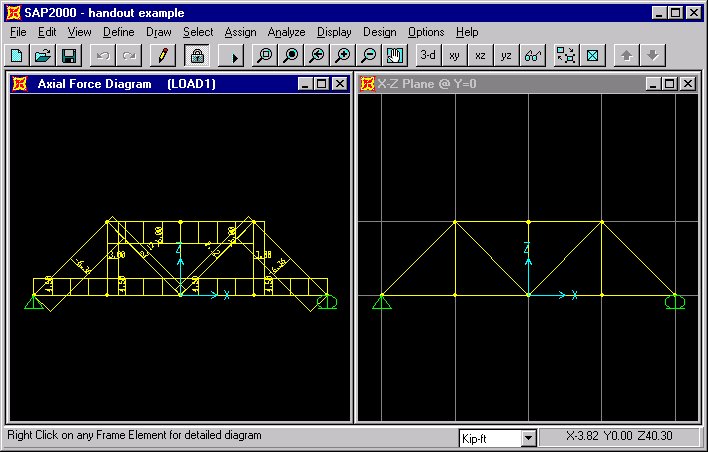

To print the results to a file click on the File menu and select Print
Output Tables and click the Print to File box. There is an option for
Spreadsheet Format if desired. The default location for the file is the same
directory as the problem files. A different location can be specified by
clicking File Name and choosing the desired file location and name.
In order to correlation the results printed in the output file to frame elements
in the structure, the frame labels turned on and printed out. To display the
frame element labels click on the Show Undeformed Shape button
 on the
main interface. Next, click on the Set Elements button on the
main interface. Next, click on the Set Elements button
 and under
the Frame section of the menu click on Labels. and under
the Frame section of the menu click on Labels.
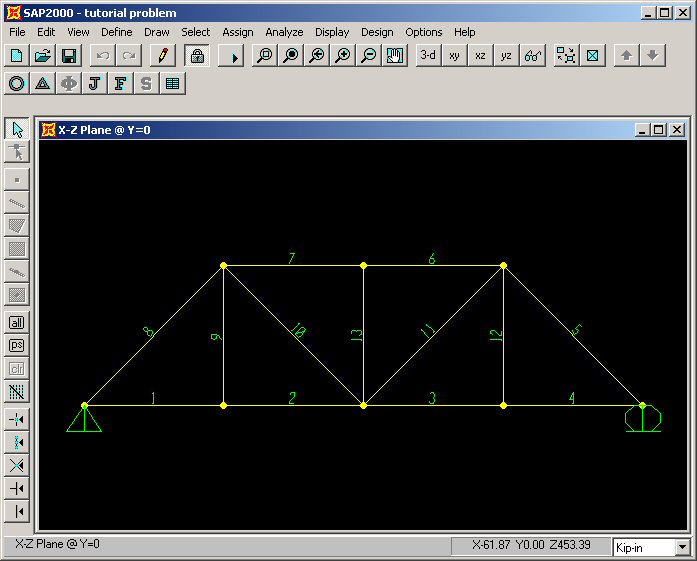
The frame element numbers, or any other information displayed in the main
SAP2000 interface, can be printed by clicking on the File menu and
selecting Print Graphics (the image will be sent to the default printer).
The results of the truss analysis presented in the output file are listed by
frame element number.
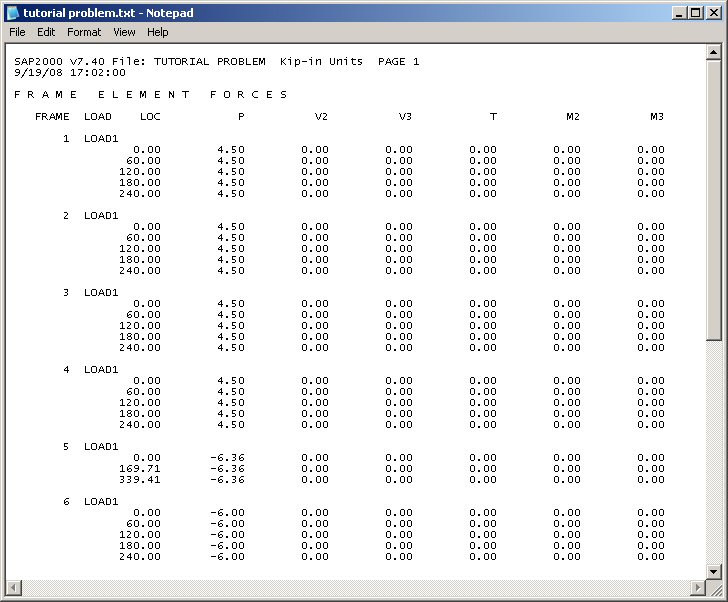
Note that SAP2000 list the variation of the internal forces and moments along
the element. For truss analysis there are no bending moments and shear forces.
The values listed in the "P" column are the axial forces in the truss members.
|



